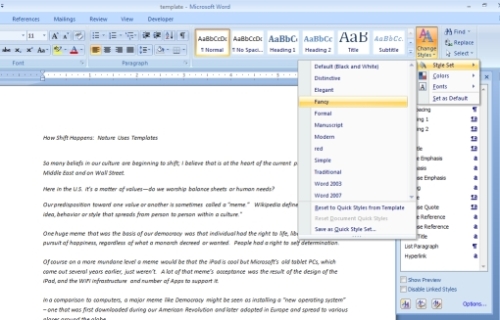 So many beliefs in our culture are beginning to shift; I believe that is at the heart of the current protests both in the Middle East and on Wall Street. Here in the U.S. it’s a matter of values—do we worship balance sheets or human needs?
So many beliefs in our culture are beginning to shift; I believe that is at the heart of the current protests both in the Middle East and on Wall Street. Here in the U.S. it’s a matter of values—do we worship balance sheets or human needs?
Our predisposition toward one value or another is sometimes called a “meme.” Wikipedia defines a Meme as “an idea, behavior or style that spreads from person to person within a culture.”
One huge meme that was the basis of our democracy was that individuals have the right to life, liberty and the pursuit of happiness, regardless of what a monarch decreed or wanted. People had a right to self determination.
Of course on a more mundane level a meme would be that the iPad is cool but Microsoft’s old tablet PCs, which came out several years earlier, just weren’t. A lot of that meme’s acceptance was the result of the design of the iPad, and the WiFi infrastructure and number of Apps to support it.
In a comparison to computers, a major meme like Democracy might be seen as installing a “new operating system” – one that was first downloaded during our American Revolution and later adopted in Europe and spread to various places around the globe.
That “Age of Enlightenment” operating system also seems to have supported the Industrial Revolution and the growth of technology, which has seen the spread of science and knowledge for its own sake, and for the sake of profit, as an “obvious set of values.” Of course these values weren’t at all obvious to the Native Americans who had no concept of the ownership of land when they signed their rights away.
But now that so many of us use computers it’s worth considering what it really means when the underlying programs can be changed, and things we took for granted can suddenly be revealed as arbitrary concepts everyone just accepted.
Some Native American cultures like the Toltecs, as described by Don Miguel Ruiz in The Four Agreements, refer to these as “dreams.”
Many of us who use computers, as Douglas Rushkoff has written in Program or be Programmed, remain obliviously unaware of the conditioning that technology can impose, especially when we don’t really understand how it works.
But if we take a closer look at computer programs we use every day, and how they operate, we can perhaps also shift our own sense of who and what we are, and what life itself is.
Bear in mind that our DNA, literally, operates as computer code. We can copy and paste it to create another species, as biologists are now doing—or to grow new organs.
So in terms of memes, or beliefs, what if we viewed them in terms of computer “Templates”?
If you’ve ever used templates in a program like Word or PowerPoint, you know the powerful way applying or opening a different template—or set of coded instructions—can alter the features of a document or presentation. You can instantly change the font types, sizes, and colors, along with a myriad of other attributes to the text or overall appearance of a file.
In genetic terms, perhaps we can see race as an obvious template for humans in terms of physical characteristics, and memes for mental or intellectual belief systems. Once a meme or cultural belief is widely adopted, it is transmitted genetically from one generation to the next.
But how are memes changed? Essentially like a new template, a cultural belief is adopted first by a small group or a few people, and then more and more.
Unfortunately for the people who suddenly come up with a new template for human beliefs, the cultures have not always been kind. Think of Jesus and Galileo as two prime examples of unconventional thinkers whose ideas caused them persecution.
But if the template or meme resonates and strikes some deeper level, of understanding a shift happens, first in individuals and eventually in entire cultures, and suddenly beliefs change.
The Gods become One God; the Sun becomes the center of the solar system, and more recently in our culture, we “know” that our location is merely that of one planet orbiting a minor star on the periphery of a galaxy among billions.
But what happens when we suddenly begin to understand the very nature of our own belief systems and templates, and realize their arbitrary nature–and the extent to which they sometimes cause us suffering?
A book that is part of a movement in just this direction is A New Earth, which opened many people up to the possibility that many of the memes and beliefs they’ve always taken for granted are misconceived—and a new template was suddenly applied to millions of peoples programming when Tolle’s work was promoted by Oprah Winfrey.
And then we might ask, what happens when we can connect the operation of life itself (DNA and Epigenetics) with the functioning of our own inner and outer worlds and belief systems?
Does the realization suddenly hit us that we are not separate “things” composed of protoplasm but rather energetically connected to a Cosmos that is itself Intelligent on a level way beyond our own—that has manifested life according to a set of intentional instructions (DNA)?
Can we drop the intellectual arrogance imposed by the scientific templates and expand our awareness?
Then looking at the stars which seem to dwarf our existence, and a newly discovered subatomic quantum world that clashes with our common sense notions of cause and effect, can we then begin to completely reconsider what is truly significant and important?
That is the shift that is taking place right now.



